Blog
Overpriced Holiday Gift #1
It’s that time of year again where I round up the weirdest gift ideas I can find in the catalogues that rain through my mailslot.
This first one is something that I might secretly want for myself if it weren’t for the price. Yes, I’m a Trekkie so this appeals to me:

It’s a Kirk and Spock Transporter Figure Set. “One shake of our water tube transporters recreates the effect [of beaming up], with flashing red, green and blue LED lights, enhanced by swirls of gold glitter.”
The hitch: the set costs $49.98 plus tax, shipping and handling. That seems kind of pricey for something I’d play with on Christmas Day and then put on a shelf to collect dust. Maybe there are Trekkies more devoted than I, but I refuse to even ask Santa to fork over $50 for this.
However, for all you lottery winners, here’s the link if you want to buy one: http://www.thingsyouneverknew.com/product/code/55944.do?showPrevNext=false
Beam me up, Scotty!
A Nod from Nancy: Soul of a Dog by Jon Katz

Jon Katz then turned to writing about dogs and the rest is history. His first doggy story, A Dog Year, about a psychotic Border Collie he rescued, made me laugh and cry at the same time. It was great stuff and hit the bestseller lists.
So I was delighted to see Soul of a Dog in my local library and snatched it up immediately. Mr. Katz has left his suburban home and moved to Bedlam Farm in upstate New York. This book talks about all of the animals on the farm although dogs are certainly central. There’s Elvis the enormous Snickers-loving steer, Henrietta the unusual hen, Mother the barn cat, along with various sheep, donkeys, and goats. Nearest and dearest to his heart are Rose and Izzy, the Border Collies, and Lenore, the Labrador. The entertaining stories about these critters are framed by Katz’s own exploration of the on-going debate as to whether animals have souls.
As an animal lover myself, I gobbled up Katz’s descriptions of his creature companions, but I also enjoyed the depth his occasional philosophical tangents gave the book. He is remarkably clear-eyed about the dangers of anthropomorphizing our pets, yet he clearly cares deeply about all of his animals.
This is a wonderful book for anyone who loves animals. I’ve already put it on my gift-giving list.
The Amazing Genius of Frank Lloyd Wright
My sister had a big birthday this year (I won’t reveal how big) and my gift to her was a trip to see Fallingwater, the famous house over a waterfall designed by Frank Lloyd Wright, something we both wanted to see. What an amazing place!

That’s me standing in the driveway beside the entrance (to the left of the photo).
The house surprised me in several ways. First, the drama of the structure is incredible. Second, it’s not fancy which makes sense since it was built as a weekend retreat for the Kaufman family of Pittsburgh, PA. Third, it blurs the lines between interior and exterior in an extraordinary way.
Below is a photo of the Kaufman family with son Edgar, Jr. in the center. He became a fan of Frank Lloyd Wright and introduced him to the Kaufman parents. They hired him to design their house which was constructed between 1936 and 1939. In today’s dollars, it cost about $2 million to build.
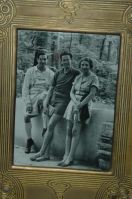
Edgar, Jr. donated the house and all its contents to the Western Pennsylvania Conservancy in 1963. What’s especially significant about that is that you see the house with the original furniture and objets d’art. The Kaufmans had some nice stuff: Picassos, Tiffany lamps and lots more. Yet the feeling is casual and comfortable as you can see in this photo of the main living area.

Wright designed all the furniture, and was especially fond of built-ins which he called “client-proof furniture” (by which he meant that his clients couldn’t mess up his design aesthetic by putting in their own tacky stuff). The weird round ball swings back into the fireplace and was for warming cider, etc. Evidently, it was more for looks than practicality: it took about 2 days to heat a beverage in it.
Right in the living room is this glass structure known as “the hatch” which could be opened so the Kaufmans and their guests could walk down the steps to the water flowing under the house.

These are the steps going down to Bear Run when viewed from outside the house.

Off the living room is one of the famous cantilevered terraces (in the photo below). When Edgar, Jr., donated the house the cantilevers were all cracking and sagging. Wright’s vision outstripped the building materials of his day so the house was in danger of dropping pieces into the water. It took $11 million and alot of creative engineering to make it structurally sound again.

You can see from these photos how the house is literally built into the lanscape, an extraordinary vision for its time. This is the foundation over the waterfall.

These supports are set into the native stone on the hill.

You can see how much Wright wanted to preserve the natural surroundings, even bending his structure around a tree.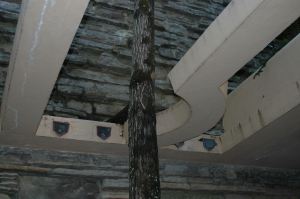
In one passageway, the wall includes a boulder in the hillside with a small spring flowing over it. Wright simply cut a drainage channel through the floor and let the spring run right through it.
Of course, with all this water, the house had some moisture problems. Evidently, Edgar Kaufman, Sr., called it “Rising Mildew”. The restoration seems to have dealt with that, although our guide said that maintenance is a constant expense.
Look at the extraordinary use of glass in this small study. When you open the windows, the forest seems to come right into the room. The floors were all stone so that when you went from the interior out onto one of the many terraces, the transition was almost seamless.
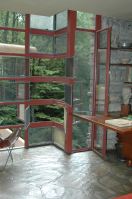
Just for fun, I thought I’d show you the kitchen. The table was designed by Wright but he didn’t care about much else there since only the servants saw it. On the other hand, he built very nice servant’s quarters up the hill so he wasn’t a total snob.

Here is the most famous view of the house, taken from downstream on Bear Run. Wouldn’t you like to live there?

Life’s Little Gifts
I’ve been feeling a little blue since my Darling Daughter went back to college. Today, life seemed to be trying to cheer me up by dropping small treasures into my day:
1) Today dawned sunny, warm and with NO HUMIDITY, something unheard of at this time of year in New Jersey.
2) Lured by the lovely weather, I took my J. D. Robb novel out on the patio to keep Brodie the Devil Dog company while he patrolled the back yard. (The J. D. Robb novel was another small treat to myself from the RWA conference in July; it’s the latest IN HARDCOVER autographed by the incomparable Nora herself.)

Brodie found one of the acorns which are beginning to rain down from our oak trees. He picked it up in his mouth, tossed it into the air, then pounced on it where it fell. Now Brodie is a handsome fellow but he’s not graceful. When he plays, his front end and back end don’t seem to quite know what each other are doing. His acorn-chasing reduced me to helpless laughter.
3) About two hours later I was headed out the back door when I saw this little fellow happily perched on our back porch, chowing down on another of the ubiquitous acorns.

He didn’t even flinch as I snapped his picture and admired his elegant racing stripes. I thought Brodie had chased all our chipmunks out of the yard, but evidently they’ve figured out my dog is a total goofball and couldn’t catch them if he tried.
4) When I took Brodie out for our evening stroll, his tail was flying high like a happy flag. (He hates heat and humidity even more than I do and has been drooping along through our walks this summer.) Usually, I use these moments alone to indulge in a little weepiness, but tonight I found myself smiling up at the nearly full moon where it glowed in the twilight sky.
Sometimes life is generous and gives you what you need just when you need it.
Houseboat Prize
I didn’t get to do much shopping while houseboating. Oddly enough, marinas aren’t filled with interesting boutiques. However, I found this fun necklace and earring set which looked very much like some lovely flowers we saw on Cabbage Key (where Jimmy Buffet wrote “Cheeseburger in Paradise”).

Real flower above. Floral jewelry below.

If you’d like a chance to win the floral jewelry, just send me an email at nancy@nancyherkness.com with “Florida” in the subject line.
Vacation Report: Wildlife viewed from a houseboat
How do you find a manatee? Look for clumps of people staring down into the water at a marina like this:

We were hugely excited when we saw our first manatees surfacing at the South Seas Plantation Marina. They’re an endangered species so we figured it was pretty special to catch sight of them. Then we saw them at the next marina where we docked…and the next one…and, well, the thrill sort of settled into a comfortable familiarity. However, we still took gazillions of photos, some of which I share with you here.
Often your first hint that manatees are in the neighborhood is the sound of air being expelled explosively as they lift just their nostrils above the water to breathe. My Darling Daughter had an authentic encounter when she was sitting on the dock, dangling her bare feet over the edge. A manatee nose rose just under her and blew manatee snot all over her toes.
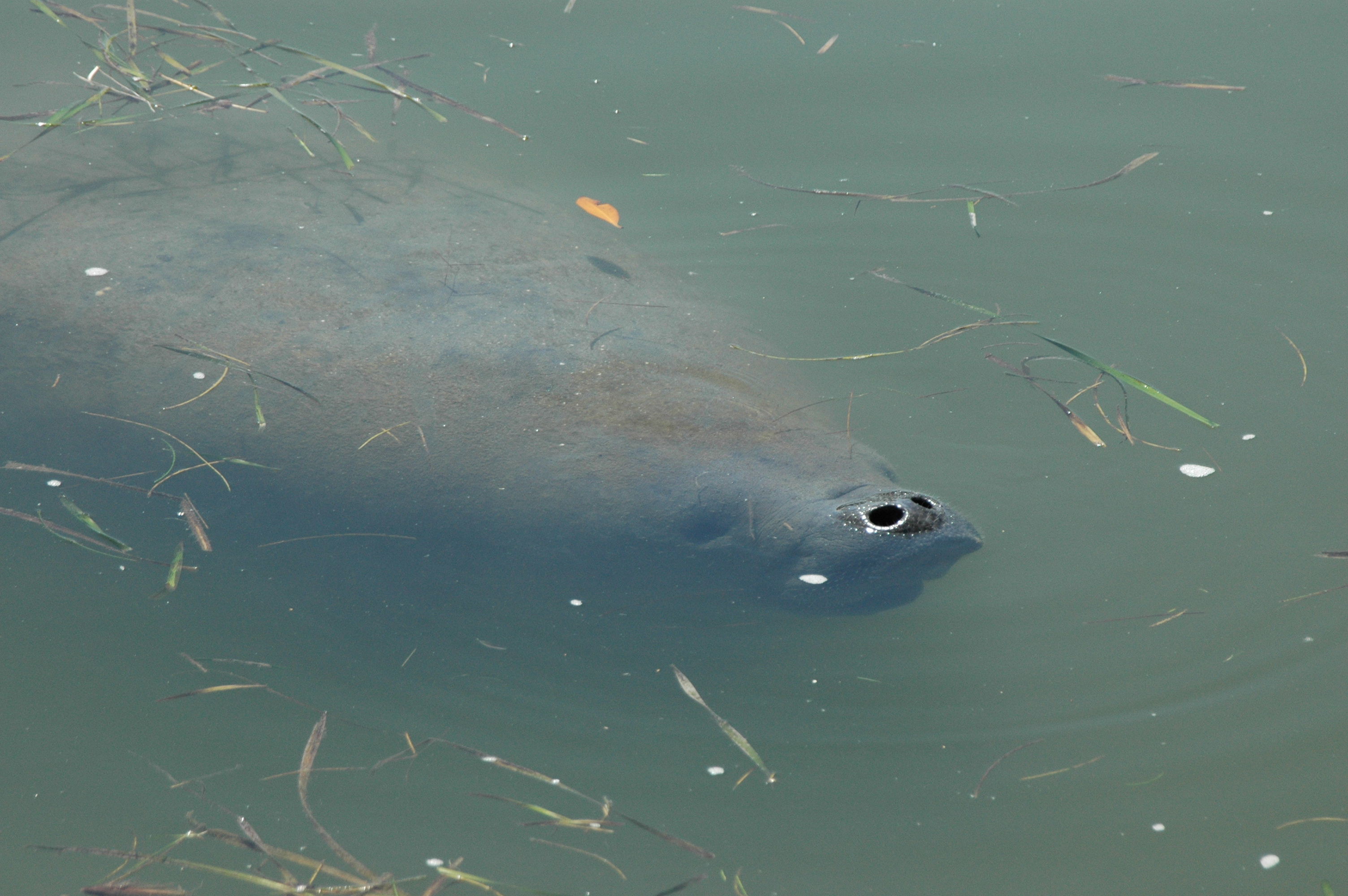
Fun facts: Manatees grow up to 12 feet long, and can weigh 1,200 pounds, most of which is NOT fat, contrary to their rather rotund appearance. They eat vegetation, such as manatee and turtle grass. They can hold their breath for as long as 20 minutes when resting. As far as we could tell, they rest a lot. My brother-in-law, a stern New Englander, was quite appalled by the manatees’ apparent lack of work ethic. In truth, they spend a lot of time feeding—6 to 8 hours a day–where we can’t see them. Manatees are closely related to the elephant although this one looks more like a seal.
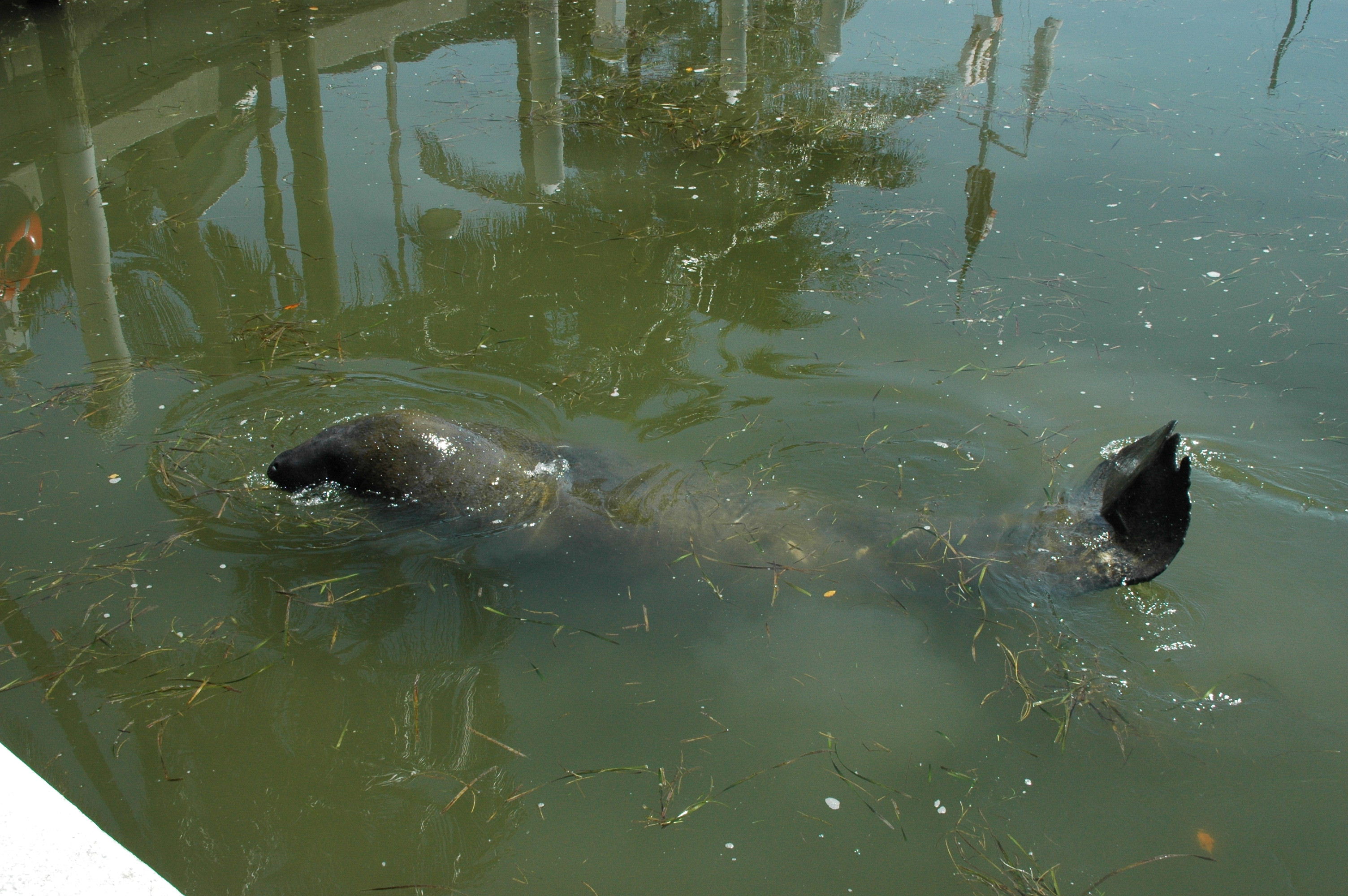
They move slowly and breed slowly, only once every 2 to 5 years, so it was pretty cool to see this mom and her baby. The baby was quite playful, spiraling around her mother in the water, and swimming away and back as though teasing her to play chase, something I can’t picture an adult manatee doing.
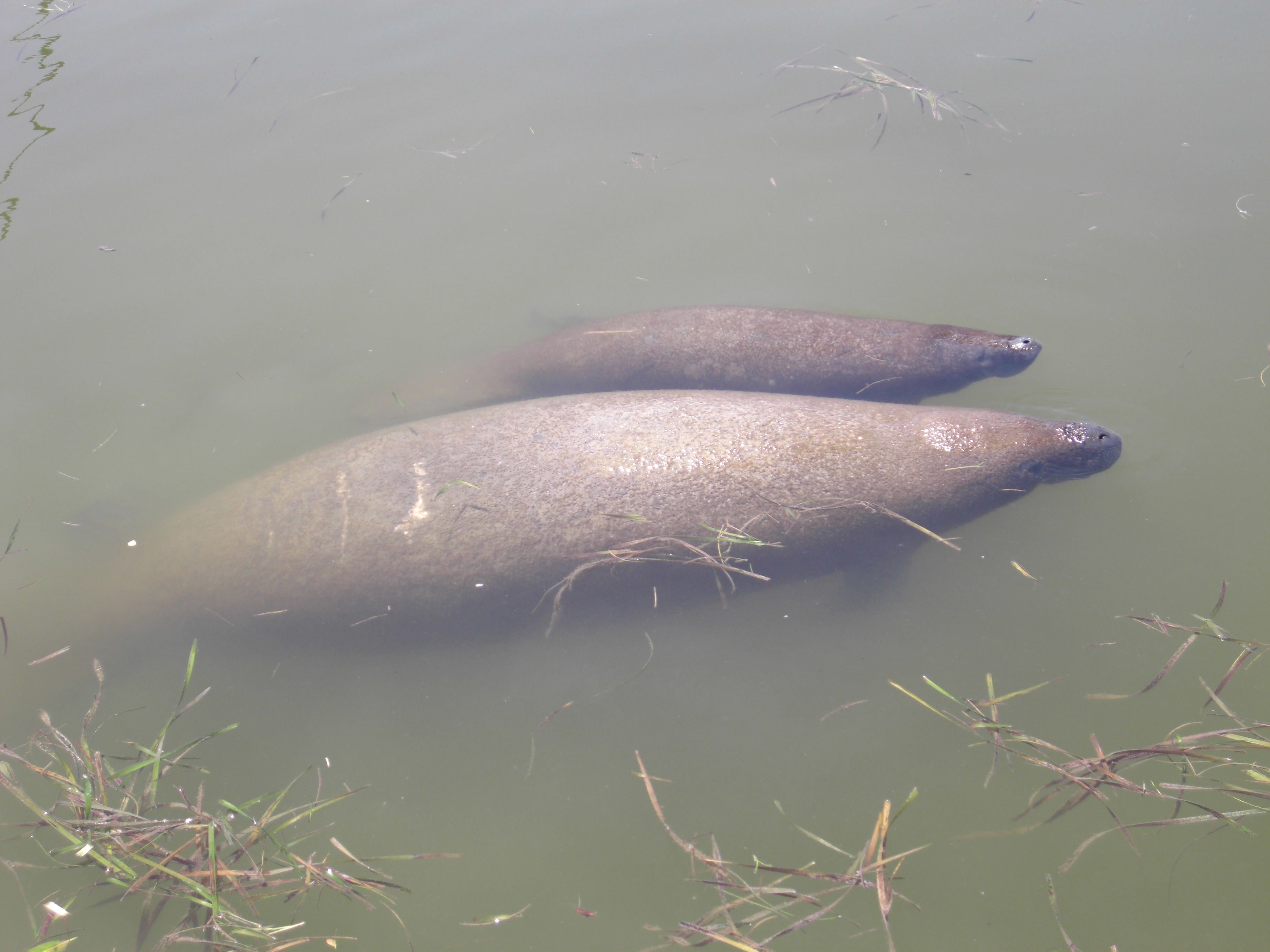
In addition to manatees, we saw lots and lots of dolphins. They move a lot faster than manatees so they’re much harder to capture on film. Most of our photos barely show a fin, and my Darling Daughter is convinced the dolphins were deliberately taunting her every time she got out her camera to photograph them.

We caught quick glimpses of sea tortoises (way too quick for photos) and saw lots of fish. On land, we met another endangered critter, the gopher tortoise (one of the Earth’s oldest living species). Doesn’t he remind you of the Slowskys in the Comcast television commercial?
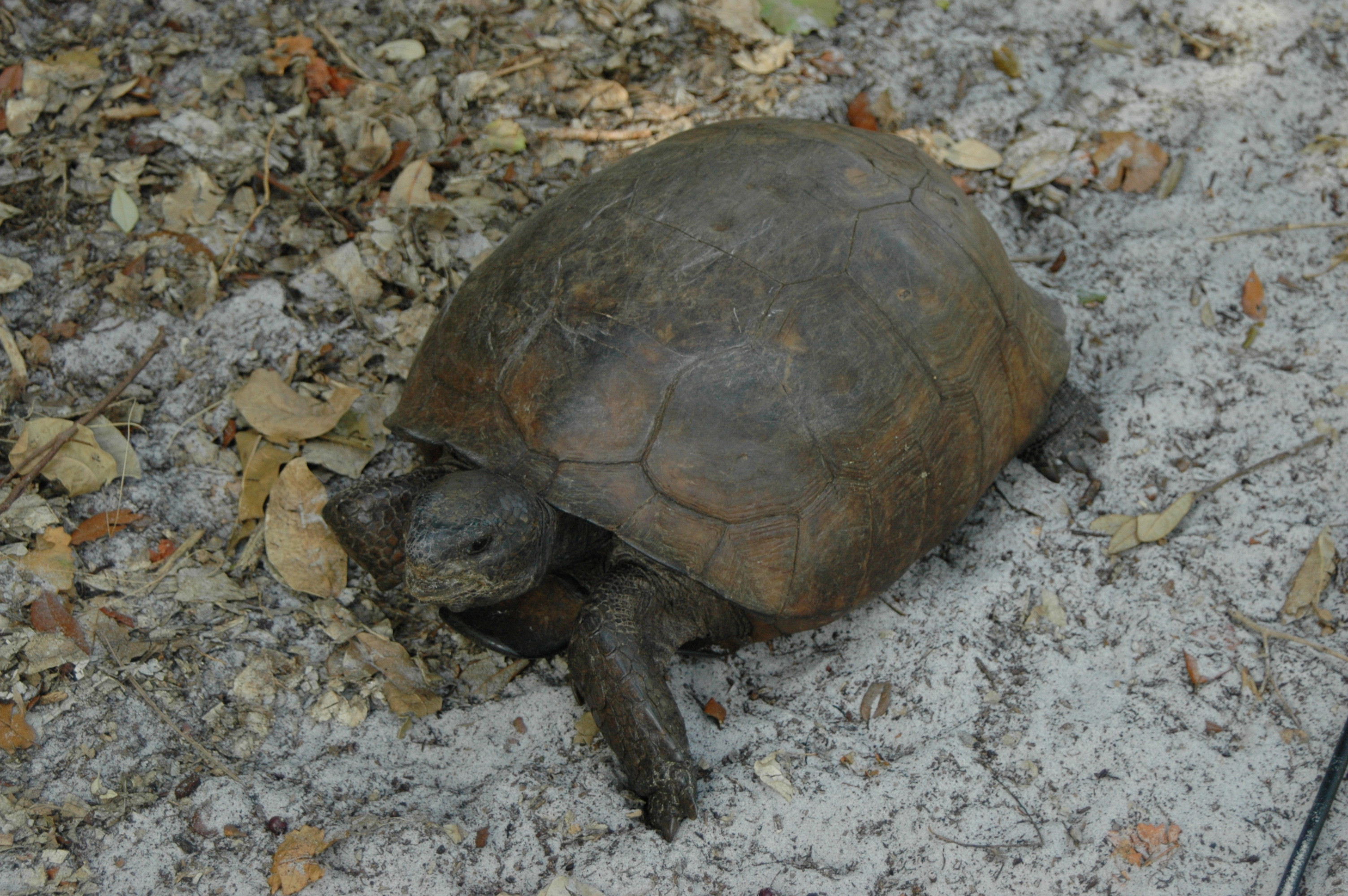
And we found a colony of fiddler crabs, reminding my sister and me of childhood days at the beach.
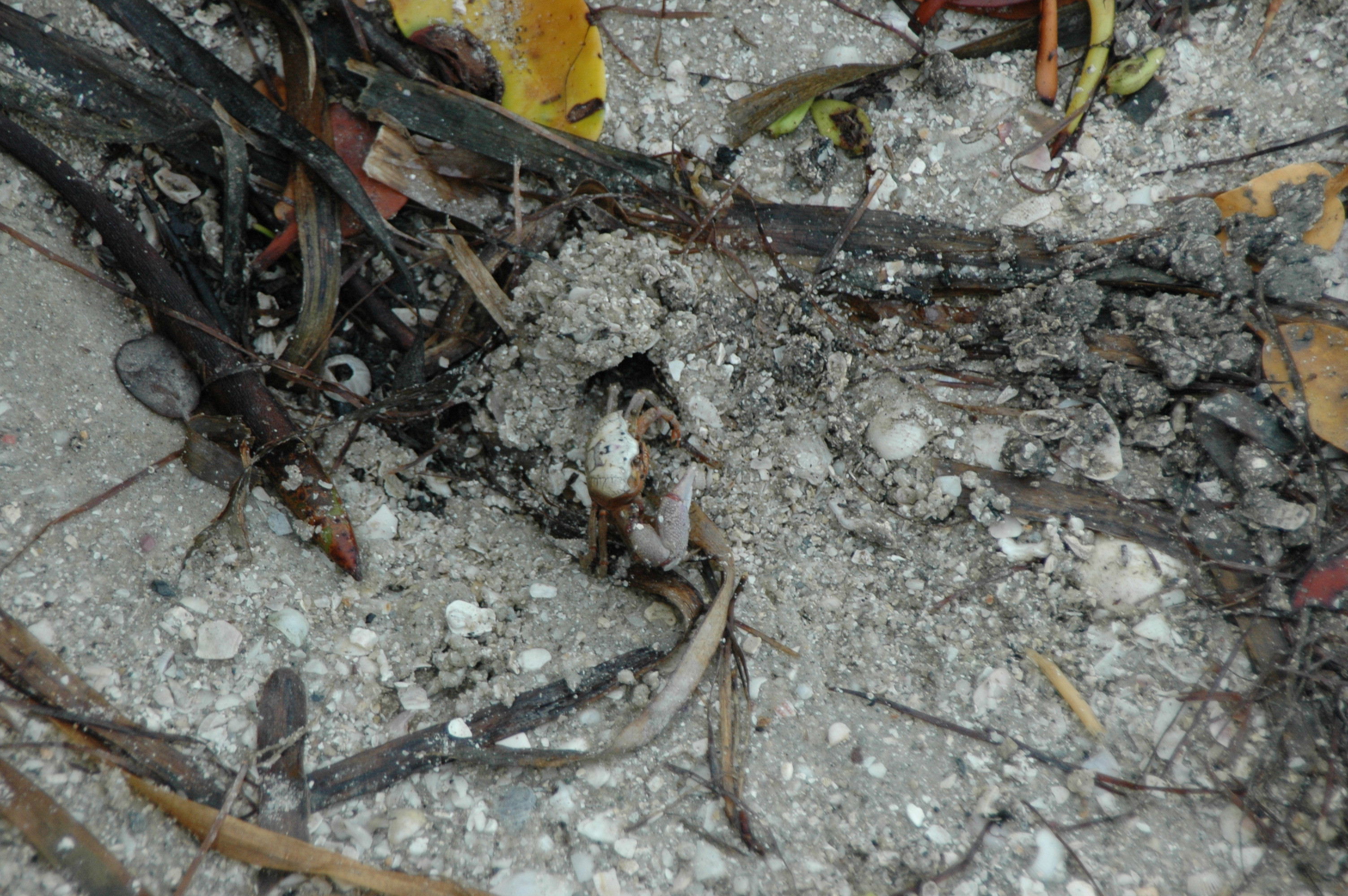
Despite all our critter encounters, we still missed Brodie the Devil Dog who was visiting Rover Ranch and Spa while we were gone. We were happy to get home for a fur fix.
Vacation Report: Houseboating in Florida…in August!
You all know my penchant for going on vacations that stretch my fairly meager spirit of adventure. Well, this was one of those. My sister somehow convinced us to rent a houseboat and cruise the Intracoastal Waterway in Florida with her and her family (who rented their own houseboat—I don’t like my sister THAT much).
Mind you, none of us had ever captained a vessel larger than a canoe before. None of us had experience reading nautical charts or coaxing diesel generators into running. None of us had a clue what we were getting into.
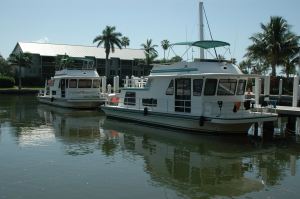 However, we traipsed down to Fort Myers, Florida, to meet Roy and our transportation, two 41-foot Gibson houseboats. Roy gave us a tutorial on how all the systems in the boat work (mostly involving the septic and electrical systems, two hugely important components of one’s life at sea). Then Kirk from Connecticut gave us a two-hour hands-on lesson in how to steer a Gibson houseboat and how to read a chart. I use the word “steer” loosely; the boats are about as nimble as garbage barges.
However, we traipsed down to Fort Myers, Florida, to meet Roy and our transportation, two 41-foot Gibson houseboats. Roy gave us a tutorial on how all the systems in the boat work (mostly involving the septic and electrical systems, two hugely important components of one’s life at sea). Then Kirk from Connecticut gave us a two-hour hands-on lesson in how to steer a Gibson houseboat and how to read a chart. I use the word “steer” loosely; the boats are about as nimble as garbage barges.
We spent the night docked and arose the next morning, ready to cast off for the high seas. One glitch: getting a houseboat out of a narrow marina without smashing any of the multi-million dollar yachts parked around us proved to be a major challenge. With the help of Roy and a couple of dockhands, we avoided the boats and only hit a few wooden pilings—gently, since Kirk and Roy advised our intrepid captains to proceed very, very slowly when maneuvering in tight quarters.
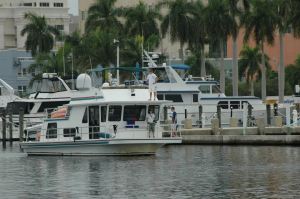
My husband took the helm. I was elected navigator because I like maps. However, a nautical chart is the reverse of a map. The land is just a greenish blob while the water has all sorts of numbers, swirly lines, and squares and triangles. You have to re-orient your thinking.
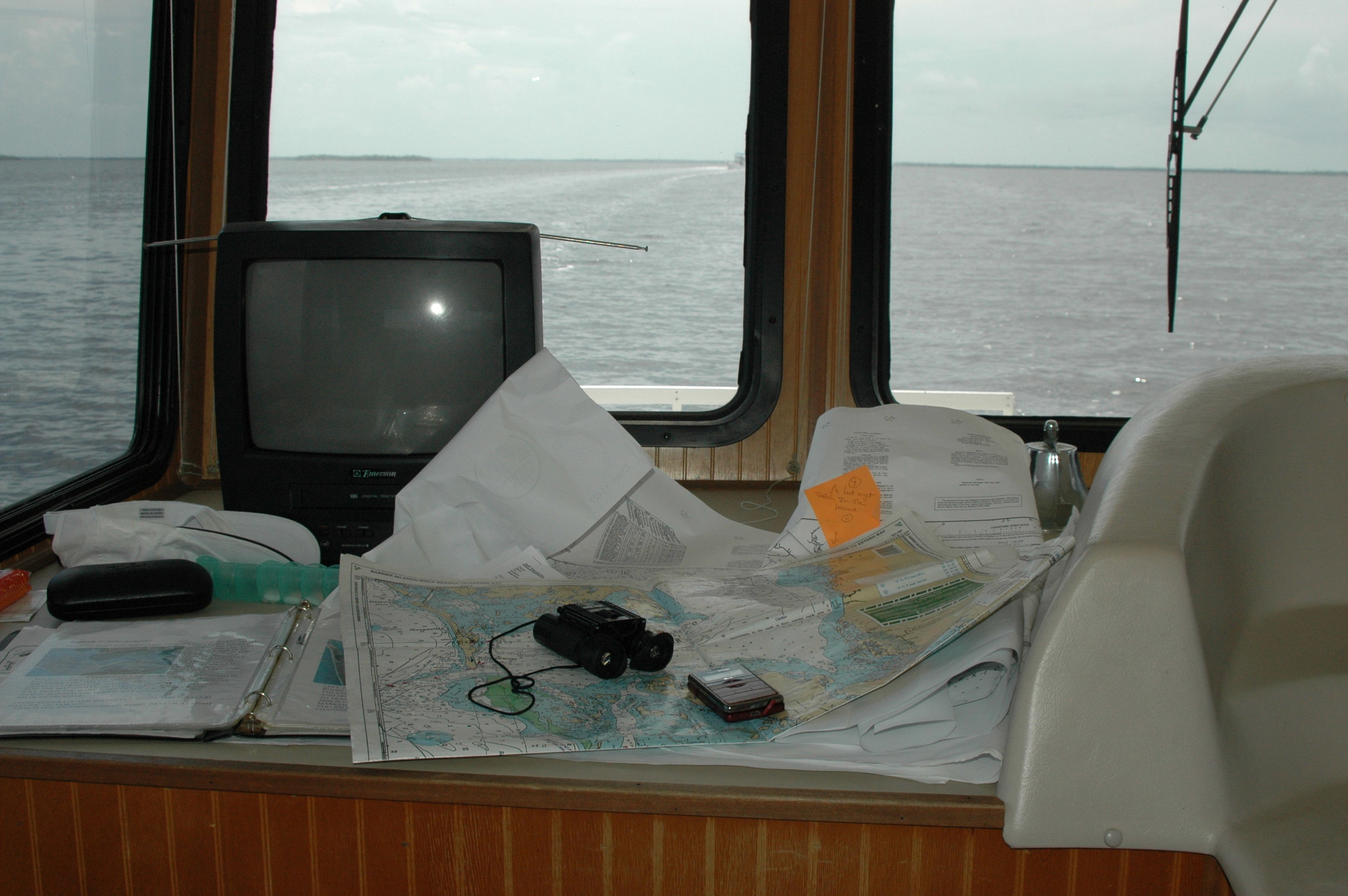
This is my navigator’s station. Note the tools of the trade: waterproof chart, binoculars (to spot teeny-tiny channel markers miles away), and cell phone (to call harbormasters for directions to their marinas, something Captain Ahab didn’t have the benefit of). The television was used by teenaged crew members to play PS2.
My father, a Navy man, always told me that when looking at buoys, remember “red, right, returning” which translates to: keep the red markers on your right when you’re coming back to port. The question is: which port are you returning to?
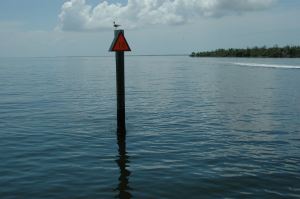
Not all went smoothly. We nearly lost our anchor due to an overconfident crew member (that would be me) uncleating the rope before the anchor was fully stowed. My husband raced onto the deck and dove into the murky water, seizing the rope before it sank out of sight. My hero!
We discovered that nautical folks are not very precise in giving directions to their marinas so we had to wing it several times as far as where we should park the boat when we arrived after the dockhands had gone home. One harbormaster came in the next morning, surveyed our neatly tied boats, and said, “Wow, I never knew a boat that big could fit into those slips.”
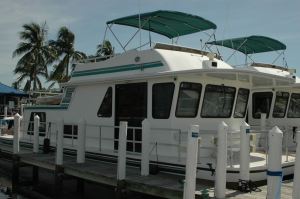
Here we are: crammed into our itty-bitty slips.
We didn’t tell him that it had taken us 30 minutes to maneuver into the slip, and that we had cheated by putting part of our crew (that would be me and two kids) onto the dock and using ropes to pull us in, while we cursed like, well, sailors (under our breath, so the children couldn’t hear).
And, of course, the septic system clogged up…but we won’t discuss that issue in polite company.
Whatever disasters we faced, the ONE humiliation I did NOT wish to suffer was calling for “Sea-Tow”. Our maritime radio was constantly buzzing with distress signals from boaters who’d run aground and needed to be towed off a sandbar. As the navigator, it was a point of pride with me that we never suffer that ignominious fate.
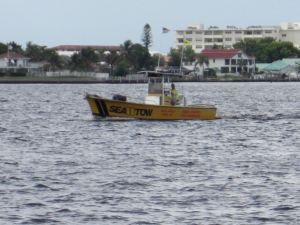
I took this photo of the dreaded tow-boat only as we came back into our final dock at Fort Myers, knowing that I could hold my binoculars high in triumph. No matter how many pilings we’d dented, no matter how much entertainment we’d provided laughing dockhands with our inept boat-handling, no matter how many times we’d called Roy to explain to us how get the generator started again, we’d never, ever spoken the terrible words “Sea-Tow”.
Check back soon for more “Adventures in Houseboating”. There might even be a prize for a lucky reader.
Conference Report: Professionalism
 Two smart, young literary agents, Jennifer Schober of Spencerhill Associates and Laura Bradford of the Bradford Literary Agency, presented part of a workshop titled How to Catch Flies: on Professionalism and Choosing Your Own Business Reputation. I say “part” of a workshop because it got interrupted by a fire alarm which meant everyone attending had to exit the Marriott and wait for the all clear. However, Ms. Schober and Ms. Bradford picked up right where they left off as soon as we were allowed back in the building because they are—you guessed it—professionals.
Two smart, young literary agents, Jennifer Schober of Spencerhill Associates and Laura Bradford of the Bradford Literary Agency, presented part of a workshop titled How to Catch Flies: on Professionalism and Choosing Your Own Business Reputation. I say “part” of a workshop because it got interrupted by a fire alarm which meant everyone attending had to exit the Marriott and wait for the all clear. However, Ms. Schober and Ms. Bradford picked up right where they left off as soon as we were allowed back in the building because they are—you guessed it—professionals.
This workshop interested me for a few reasons. One, I think that, of all the folks in the publishing biz, agents have to be most concerned with projecting a professional persona, so they know a thing or two about how to do it well. Two, I hoped it would give me new insight into how agents think. Three, I had a question I really wanted to have answered. All three of my reasons for attending were addressed.
Here’s a summary of my notes:
1) Don’t let your business persona just happen. Be thoughtful about how you wish to appear to the public. This is especially important in the on-line world. Remember that anything you put on-line stays there forever for anyone to access. This means your Facebook page, your blog, your website, your Twitters, etc., should all contain material that enhances your reputation as a professional writer. Even your Flickr photos should not show anything that could prove embarrassing, or even just too personal. Be careful what you say in emails on email loops, even closed ones. Things get forwarded.
2) There are four things an agent expects from a good working relationship with an author:
a) Timeliness;
b) Respect and common courtesy;
c) Confidentiality;
d) A sense of responsibility and a strong work ethic.
3) Have attainable benchmarks for your career. There is so little that you can control about the publishing business; set goals you CAN have an effect on. It will make you feel better.
4) Communication is very important. Talk to your agent first about your needs and/or concerns. Both agents stressed that they nurture communication with their clients. They don’t want you to stew and be unhappy, nor do they want to be blind-sided by problems you haven’t discussed with them.
5) You can get ahead by being “kind”. Ms. Bradford mentioned that some people seem to feel you must be a “squeaky wheel” to succeed in publishing. She disagrees. Kindness pays dividends.
6) Now for my own burning question. I always hear folks say that they pitched to an agent or editor “in the elevator” at a conference. Okay, I hate pitching, my room was only on the fifth floor so the ride was very short, and I can’t imagine doing more than smiling and saying hello in an elevator. Is this really something I should attempt to do?
Ms. Bradford laughed and said that if she’s at a conference, she expects to be approached by writers looking for representation. Her script was:
Writer (reads agent’s nametag as she enters elevator): Hi, Ms. Agent. I’m Nancy Herkness. I wondered if you’re interested in representing romantic suspense?
Ms. Agent: Yes, I am.
Writer: May I send my romantic suspense proposal to you?
Ms. Agent: Of course. Here’s my card. Please email it to me after the conference.
Elevator doors open.
Writer: Thank you. It was nice to meet you.
Writer goes directly to bar and has three Cosmopolitans to calm frazzled nerves.
All right, the last stage direction was my own addition to the script. However, I was relieved to hear that it’s considered acceptable to approach an agent at a conference without prior contact. Of course, I would never do anything rude, like interrupting a conversation or stalking them into the Ladies’ Room (these things have happened, evidently). That wouldn’t be professional.
A Nod from Nancy: Still Alice by Lisa Genova
Often sad, sometimes frightening, always compelling, Still Alice, the story of a Harvard professor with early-onset Alzheimer’s disease, is told with a clear-eyed compassion which keeps the reader racing to turn the pages. I was afraid this novel would be depressing, but amazingly it isn’t. 
This is not a caregiver’s handbook; it’s fiction, but it will instill in any reader who knows a person with dementia a more profound understanding of how to better communicate and simply be with them. For those fortunate enough not to have a friend or family member affected by the disease, Still Alice offers insight into how our own brains function…or not. If the true measure of a book is whether it changes your perception of some part of the world you live in, then this is a great one.
Still Alice begins with Professor of Psychology Alice Howland tracking down her equally academic husband’s glasses for him as he tries to get to work on time. While she feels the usual wifely exasperation at John’s inability to find his own keys, etc., she also empathizes since she has recently noticed that she’s losing things too, such as her Blackberry, which she later finds plugged into its charger beside her bed. Alice chalks this up as normal for a multi-tasker who’s fifty years old. The reader finds it more ominous since author Lisa Genova has opened the book with a single dramatic paragraph saying that “there were neurons in her head…that were being strangled to death, too quietly for her to hear them.”
After Alice goes running and can’t find her way home from Harvard Square, a place she knows like the back of her hand, she begins to worry that her forgetting is more than just a menopausal woman’s typical memory difficulties. Without telling anyone in her family, she begins the process which results in the diagnosis of early on-set Alzheimer’s. As she reads a list of activities which will be affected throughout the progression of the disease, she finds the items: “Has given up reading. Never writes. No more language.” Alice is a specialist in neurolinguistics, the study of the mechanisms of language.
She looked at the rows of books and periodicals on her bookcase, the stack of final exams to be corrected on her desk, the emails in her inbox, the red-flashing voice-mail light on her phone. … She had experiments to perform, papers to write, and lectures to give and attend. Everything she did and loved, everything she was, required language.
In clear, lucid prose, Ms. Genova shows us how Alice’s family responds to the diagnosis, how she tries to compensate for the symptoms as she continues to teach at Harvard, how her colleagues avoid her once the diagnosis is made public, and, most important, what Alice herself is thinking, feeling, and struggling with. In a very unusual and gutsy choice, the author tells the story from Alice’s point-of-view. The reader lives in Alice’s mind as that mind betrays her with increasing frequency.
And yet, there are gifts the disease gives her. As she loses the ability to absorb words, her sensitivity to body language increases. Her relationship with her youngest daughter improves dramatically. She no longer bases her entire identity on her achievements at work. She comes to understand love on a deeply felt level.
Interestingly, the author spent a year querying and being rejected by agents who said no one would want to read a novel about Alzheimer’s. Frustrated, Ms. Genova decided to self-publish the book, which is so well researched it received the stamp of approval from the Alzheimer’s Association. After a year of selling Still Alice out of the back of her car, Ms. Genova was contacted by an agent who sold it to Simon & Schuster for half a million dollars. Now the book is a New York Times bestseller.
Conference Report: The Perfect Pitch
 Honestly, I hadn’t planned to go to this workshop. I’ve read articles, attended presentations, and done pitches already. Pitching is second only to writing a synopsis in my list of things I’d rather run through a swarm of angry bees than do. However, when I looked at the lineup of presenters, I decided it would be highly entertaining as well as educational…and I had a pitch to do later in the day so the timing seemed fortuitous.
Honestly, I hadn’t planned to go to this workshop. I’ve read articles, attended presentations, and done pitches already. Pitching is second only to writing a synopsis in my list of things I’d rather run through a swarm of angry bees than do. However, when I looked at the lineup of presenters, I decided it would be highly entertaining as well as educational…and I had a pitch to do later in the day so the timing seemed fortuitous.
The full title of the workshop is How to Make the Perfect Pitch (without Striking Out). The speakers were: Christie Craig, Faye Hughes, Caren Johnson, Christopher Keeslar, and Kim Lionetti. For anyone who’s never heard Christie and Faye speak, you should know that they are hilarious. And who better to discuss the fine points of pitching than the folks we’re pitching to: an editor and two agents?
I kid you not when I say that this workshop completely changed the attitude with which I approached my pitch later that afternoon. And you know, the pitch went ten times better as a result.
So what made this workshop so life-changing for me? First, they got us laughing with a video about how NOT to pitch, featuring Kim Lionetti and Chris Keeslar literally chained to their chairs in the “pitch room”. So that relaxed the audience.
Relaxation is the key. The single most important thing I learned was something I’d heard before but from a different angle. Everyone always tells you not to be nervous because editors and agents are nice people who don’t bite, and one pitch isn’t going to make or break your career. It won’t even generally affect whether they request the book or not. All very, very true, but none of it ever stopped me from developing a flop sweat before I went in to pitch.
Here’s the point that revolutionized my thinking: Don’t make the agent or editor focus on YOU rather than your book. If you’re overtly anxious, shaking, or sweating, they’re going to waste time and energy trying to calm you down. You want all their time and energy directed toward your masterpiece.
This comment was reiterated by all the industry pros on the panel. It makes THEM nervous when the author is nervous. They want to be able to relax and enjoy your pitch, not worry that you are going to have a mental breakdown at any moment.
Doesn’t that make total sense?
Okay, on to specifics.
Here’s what to include in your pitch:
1. High concept, as in, Godzilla meets Sleeping Beauty;
2. Very short synopsis OR Goal/Motivation/Conflict for the main character, if that works better for you. This should be 2-3 sentences long and include:
Situation
Character
Objective
Opponent
Disaster.
Another way to approach this is to answer these questions about the heroine/hero:
Why are they appropriate to the book?
What makes them distinctive?
Why do we care?
What’s most interesting about them?
What’s the push and pull between them?
What creates the dynamic for the relationship?
3. A sense of the writing tone by comparing it to another well-known author;
4. Word count;
5. Genre;
6. If you have publishing credentials which are relevant to the project you are pitching, mention them at the end of the pitch.
Presentation Tips:
1. Practice with someone who will give you a good critique.
2. Practice pitching someone else’s book or movie. It can give you insight into what’s most important.
3. Research who you’re pitching to so you can personalize it a bit. For example, mention you love an author they represent or edit.
4. Breathe!
5. Pay attention to your pitchee’s responses. Do they look bored? Concerned? Confused? Adjust!
6. Be passionate about your work! Demonstrate why you care about this book.
7.Convey the pitch in a short time so the agent/editor has time to ask questions and go deeper into what interests them.
8. Show you’re a professional by staying calm and knowing what you’re trying to accomplish. Remember: you’re the expert on your book and present yourself that way.
9. Talk in a natural way which means keeping the “blurb” short.
10. Feel free to ask business-related questions if you have time.
Here’s what NOT to do:
1. Do not rush through your prepared pitch.
2. Do not read your pitch. Note cards are okay if you must refer to them, but this is supposed to be more of a conversational meeting.
3. Do not include extraneous information. There’s no time for it.
4. Do not pitch more than one project. You have to show that this project is your passion. If it’s one in a series, you can touch briefly on that fact at the end of the pitch.
5. Do not mention you’ve self-published a book unless it sold 10,000 or more copies.
Chris Keeslar noted that he will almost always request the book pitched to him if it’s in a genre he publishes. If your pitch really excites him, he’ll read your submission first. (He also mentioned he only buys straight contemporary romances if they have humor in them.)
Kim Lionetti said you build relationships by meeting agents and editors at conferences over time. She feels the face-to-face meetings are valuable.
All the industry pros confirmed that submissions made as the result of a face-to-face pitch go on the top of their reading pile. So you see, the angst is well worth it.
